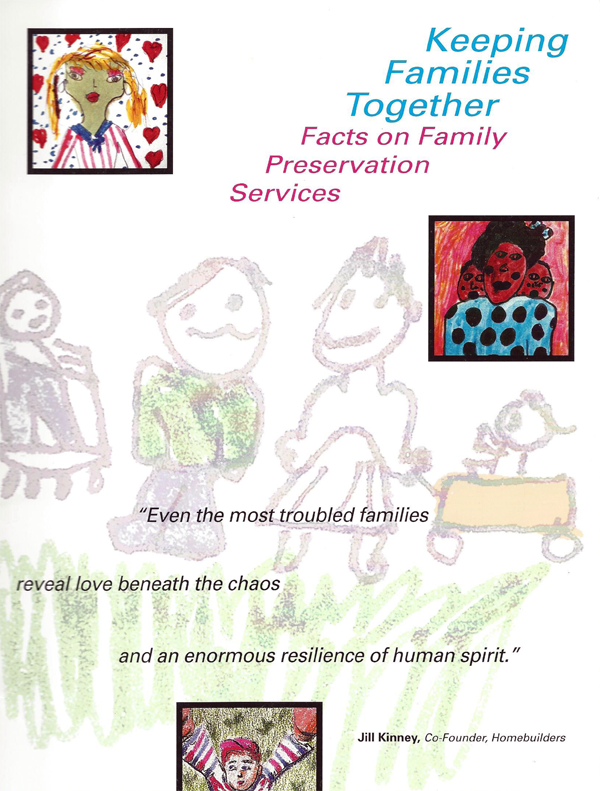 Did you know that the term “family preservation” did not exist 40 years ago?
Did you know that the term “family preservation” did not exist 40 years ago?
We’ve come a long way in the past 40 years! From no use of the term “family preservation” before 1974 to over 37 million Google listings for “family preservation” in 2014.
IFPS got off to a strong start, was boosted with a strong dose of private foundation and federal government support, experienced a rough patch for a period of time, and is now growing and stronger than ever.
Come along for the journey for the next 40 years!
Birth of IFPS
In 1974 the HOMEBUILDERS® program, a model of Intensive Family Preservation Services (IFPS), began in Washington State. Its goal—strengthen families and prevent unnecessary out-of-home placement.
The federal government provided impetus for nationwide replication of IFPS through the Adoption Assistance and Child Welfare Act of 1980. This act required states to provide reasonable efforts to prevent or eliminate the removal of children from their homes or make it possible for them to return home. Family preservation services were listed as an essential component of satisfying the reasonable efforts requirement.
Foundation and Federal Funding for IFPS
The private sector stepped up to provide key funding for IFPS.
- In 1986 the Edna McConnell Clark Foundation awarded $3.3 million for development of model programs, training/technical assistance, and capacity building.
- In 1992, the Clark Foundation funded 7 existing organizations to promote IFPS.
- Both the Clark Foundation and the Annie E. Casey Foundation provided funding to establish a new organization, the National Family Preservation Network (NFPN). NFPN is the only national organization whose mission is to serve as the primary national voice for the preservation of families.
By 1993 IFPS programs existed in 35 states with 12 states passing specific family preservation legislation. That was also the year that federal funding first became directly available for IFPS through the Family Preservation and Support Act, later changed to the Promoting Safe and Stable Families Program (PSSF).
The program was expanded to include funding for reunification and adoption services as well as family preservation and prevention. About one-fourth of the annual federal funding goes to family preservation.
Title IV-E Waivers
In 1994, Congress passed Public Law 103–432, which established Section 1130 of the Social Security Act (SSA) and gave the Secretary of the Department of Health and Human Services (HHS) the authority to approve state demonstration projects, now referred to as IV-E waivers.
Conceived as a strategy for generating new knowledge about innovative and effective child welfare practices, waivers give states flexibility in the use of federal funds for alternative supports and services that promote safety, permanency, and well-being for children in the child protection and foster care systems.
Waivers allow funding and programs to prevent foster care, including authorization for IFPS as well as reinvestment of public funds that are saved through prevention of costly out-of-home placement. Congress is currently authorizing up to 10 new waiver projects annually.
Fidelity Validates IFPS
In 2001 a federal study indicated that IFPS was not effective in preventing out-of-home placements of children. Subsequent studies addressed methodological problems in the federal study. A breakthrough came in 2006 with a study conducted by the Washington State Institute for Public Policy (WSIPP). WSIPP did a meta-analysis of 14 IFPS evaluations based on fidelity to the Homebuilders® model of IFPS. The results from the combined 14 studies showed no significant effect on out-of-home placements.
But the programs with demonstrated fidelity to the Homebuilders® model reduced out-of-home placement by 31%. In addition, the high-fidelity programs produced $2.54 of benefits for each dollar of cost.
IFPS is Effective With a Variety of Families
A study conducted by NFPN found that the positive results of IFPS are not diminished when working with families of color, families involved with substance abuse, or families referred for neglect.
In the next post we’ll take a closer look at the target populations with which IFPS has been found to be effective.
_______________
Posted by Charlotte Booth, Executive Director, Institute for Family Development
and Priscilla Martens, Executive Director, National Family Preservation Network
